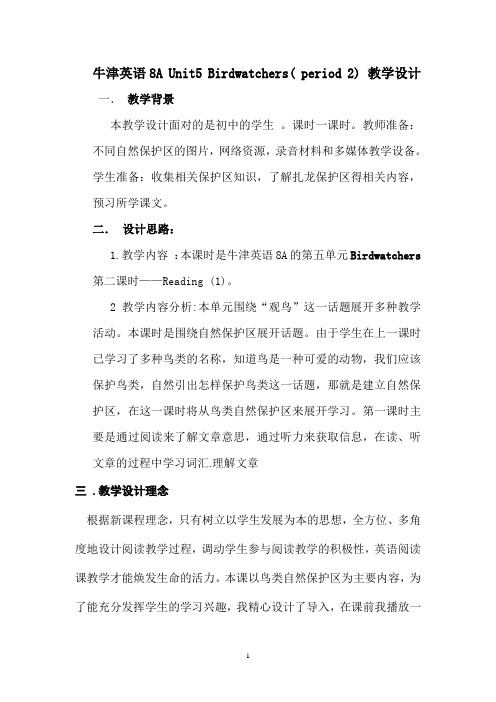译林版牛津初中英语英语(8A)教学设计案例
- 格式:doc
- 大小:64.00 KB
- 文档页数:5

Unit 4 Wild animalsGrammarStep 1 Free TalkTalk about wild animals.Step 2 presentationWhat will happen if you come to school late ?I will miss some classes.If I come to school late.用if合并成一句I will miss some classes if I come to school late.What will happen tomorrow ?It will be sunny tomorrow.We will have a trip tomorrow.We will have a trip if it is sunny tomorrow.If在此引导一个条件状语从句。
当主句是一般将来时时,if引导的从句必须用现在时来表示将来可能发生的动作或存在的状态。
Step 3 Excercises用if合并成一句It is going to rain tomorrow.I will stay in bed.If it rains tomorrow, I will stay in bed.I will stay in bed If it rains tomorrow.Section A 1. Match.1.If I see a snake in front of me, ____ a I will see a lot of camels.2.Giant pandas will survive _____ b I will go to the zoo.3.I will see some beautiful birds ______ c If we protect them.4.If I go to North Africa, _____ d I will run the other way.5.If I have time next weekend, _____ e if I walk through a rainforest. Section A 2Why do I want to go to Beijing Zoo?Talk about it.Complete and check.2.You will have a good time if ____________.练习:思考并完成下面的句子.1.If it doesn‟t rain tomorrow, we will______.3.Look at picture and Make up sentences using “if”.If tigers are hungry.用if合并成一句If tigers are hungry, they attack people.If在此引导一个真实条件状语从句。


牛津英语8A Unit5 Birdwatchers( period 2)教学设计一.教学背景本教学设计面对的是初中的学生。
课时一课时。
教师准备:不同自然保护区的图片,网络资源,录音材料和多媒体教学设备。
学生准备:收集相关保护区知识,了解扎龙保护区得相关内容,预习所学课文。
二.设计思路:1.教学内容:本课时是牛津英语8A的第五单元Birdwatchers第二课时——Reading (1)。
2教学内容分析:本单元围绕“观鸟”这一话题展开多种教学活动。
本课时是围绕自然保护区展开话题。
由于学生在上一课时已学习了多种鸟类的名称,知道鸟是一种可爱的动物,我们应该保护鸟类,自然引出怎样保护鸟类这一话题,那就是建立自然保护区,在这一课时将从鸟类自然保护区来展开学习。
第一课时主要是通过阅读来了解文章意思,通过听力来获取信息,在读、听文章的过程中学习词汇.理解文章三 .教学设计理念根据新课程理念,只有树立以学生发展为本的思想,全方位、多角度地设计阅读教学过程,调动学生参与阅读教学的积极性,英语阅读课教学才能焕发生命的活力。
本课以鸟类自然保护区为主要内容,为了能充分发挥学生的学习兴趣,我精心设计了导入,在课前我播放一个女大学生为救一只丹顶鹤而失去生命的故事改编的歌曲,调动了学生阅读的欲望,从而积极主动地参与到阅读学习中来。
在本课结尾,我播放了赵传的《小小鸟》及动画,引导学生讨论怎样来保护鸟类。
本节课课堂教学设计由易到难,由浅入深,听读结合。
有助于学生课堂上集中精力,积极思考,主动参与课堂活动,培养学习策略,提高学习效率。
四、教学目标:1.知识目标:学生能认读并理解本课词汇;重点句型。
All year round;make more space for farms ; in danger ;understand the importance of the wetlands ;take action to protect wildlife The area provides food and shelter for wildlife .This means there will be less and less space for wildlife W e need more people to help us count and do something to help the birds .2.能力目标:(1)能听懂本课文的语段,识别主题,获取主要信息(2 )学生能够通过阅读故事,了解扎龙自然保护区的基本情况,获取所需信息;3.情感目标:使学生了解自然保护区,培养关爱自然、保护鸟类的意识,激发学生学生学习英语兴趣,培养小组合作精神。

牛津译林版八年级下册Unit 8《A green world》教学设计8一. 教材分析本单元的主题是“绿色世界”,通过本单元的学习,学生将了解环境保护的重要性,学习如何保护环境,提高他们的环保意识。
教材中包含了丰富的环保相关词汇、句型和对话,为学生提供了丰富的语言材料。
二. 学情分析八年级的学生已经掌握了基本的英语语法和词汇,具备一定的听说读写能力。
他们对环保有一定的认识,但对于如何用英语表达环保观点可能还不够熟练。
因此,在教学过程中,需要关注学生的个体差异,因材施教,鼓励他们积极参与课堂活动。
三. 教学目标1.知识目标:学生能够掌握本单元的生词、短语和句型,了解环境保护的相关知识。
2.能力目标:学生能够用英语进行简单的环保话题交流,提高他们的听说读写能力。
3.情感目标:培养学生环保意识,使他们认识到保护环境的重要性。
四. 教学重难点1.重点:本单元的生词、短语和句型。
2.难点:如何运用所学知识进行环保话题的交流。
五. 教学方法1.任务型教学法:通过完成各种环保相关的任务,激发学生的学习兴趣,提高他们的实践能力。
2.情境教学法:创设真实的环保情境,让学生在实践中学习英语。
3.合作学习法:鼓励学生分组合作,进行互动交流,培养他们的团队精神。
六. 教学准备1.教学PPT:制作包含本单元重点内容的PPT,以便进行课堂展示。
2.教学素材:收集一些与环保相关的图片、视频等素材,用于课堂讨论。
3.学生分组:将学生分成若干小组,每组选一个组长,负责课堂活动。
七. 教学过程1.导入(5分钟)教师通过向学生展示一些环保相关的图片,引导学生谈论环保话题,激发他们的学习兴趣。
2.呈现(10分钟)教师通过PPT展示本单元的生词、短语和句型,让学生进行初步感知。
3.操练(15分钟)教师学生进行小组活动,让学生用英语进行环保话题的交流,鼓励他们大胆开口。
4.巩固(10分钟)教师通过一些练习题,检查学生对生词、短语和句型的掌握情况,及时进行反馈。

江苏译林版牛津初中英语8A教学大纲(全册)1. 课程目标- 掌握基本的英语语法和词汇知识。
- 培养听、说、读、写的能力,提高语言综合运用能力。
- 研究并了解英语国家的文化和俗。
2. 教学内容Unit 1: Getting to know you- 语法:be动词的用法、一般现在时- 词汇:人称代词、职业、国籍、家庭、个人描述- 阅读:介绍自己和他人、问候语- 听力:日常问候、简单交流- 写作:写一篇介绍自己的文章Unit 2: Our school life- 语法:there is / there are的用法、一般现在时- 词汇:校园、教室、学科、学校活动- 阅读:学生活动介绍、校园介绍- 听力:询问和提供信息- 写作:写一篇关于学校生活的日记Unit 3: A taste of English- 语法:可数和不可数名词、some和any的用法- 词汇:食物、餐厅用语、食物喜好- 阅读:英式早餐、午餐和晚餐介绍- 听力:点菜、询问和提供意见- 写作:写一篇关于你最喜欢的食物的文章...(依此类推,每个单元列出相关内容)3. 教学方法- 教师讲解和示范- 学生课堂互动,口头表达和书面练- 组织小组活动和角色扮演- 配备适当的教学资料和多媒体资源4. 评估方式- 课堂测试和作业- 听说读写各项能力的考查- 小组项目和个人报告- 学期末考试5. 教学资源- 课本:《江苏译林版牛津初中英语8A》- 多媒体资源:录音机、投影仪等以上为《江苏译林版牛津初中英语8A教学大纲(全册)》的简要介绍,具体内容请参考课本和教学资源。

英语牛津译林八上Unit 4:教案(全单元教案)《牛津初中英语》8A Unit 4 Wild animalsComic strip& Welcome to the unit一、教学目标1 了解对话内容,掌握重点词组及初步了解if句型的用法2. 熟悉学习更多有关野生动物的词语二、教学重难点学生讨论表达对动物的喜好三、教学流程Step1 Comic stripHobo and Eddie have a new problem now. Listen to the tape and answer the following questions.1 What does Hobo want to do?2 Is Eddie willing to share his food?Language points:look delicioustalk to/with sblook after/ take care ofAsk students to pay attention to‘if’clauses Step2 VocabulariesAsk students to look at the pictures and learn new words about wild animals.bear dolphin giant panda kangaroo squirrel tigerStep3 Guessing gamesLet students paly a guessing gane to engage them.One student describes and the other guess ‘What animal is it?’Step 4 Make a surveyAsk stuents to work in pairs. Complete the survey form on P59Step5 DiscussionA: Which animal do you like best?B: I like ……best.A: Why?B: Because they are …...A: Which animal do you like least?B: I like…… least.A: Why?B: Because they are …...Step 6 HomeworkRemember all the words about wild animals and try to describe them.《牛津初中英语》8A Unit 4 Wild animalsReading1一教学目标1.知识目标1.)知识并运用本课时的四会单词。
牛津初中英语教学设计8A U n i t5R e a d i n g T h e s t o r y o f X i W a n gTeaching design――The story of Xi WangThis teaching design is made up of 6 parts, including analysis of teaching material, analysis of students, teaching objectives , teaching methods, teaching theories and procedures.Analysis of teaching materialThis article, the story of Xi Wang , is from the reading part of Unit 5, 8A, Fun with English. The topic, wild animals, accords with the cognitive ability and lives of students. This course requires that students read a passage about lives of giant pandas. By learning it, students can know the growing process of pandas and develop the awareness of protecting wild animals by exploring the dangers giant pandas face.Analysis of studentsThe target students are in level 4, they have certain reading ability. Their listening and speaking ability are enhanced in a certain degree. They have learning consciousness. With regard to the condition above, I will train their reading ability further and develop their comprehensive language skills by listening, reading, speaking and writing activities.Teaching objectivesStudents are able to(1) get to know some basic information of Xi Wang.(2) be familiar with and identify the new words and expressions: serious, none, mainly, be born, in the beginning, take action, look like, eat bamboo, live on, face serious problems, in the wild, in danger, right away.(3)improve reading ability by training skimming and scanning.(4) raise awareness of protecting wild animals by knowing the truth that many wild animals are in danger.Teaching methodsTask-based language teaching, communicative language teaching and the guided-discovery method.Teaching theories(1)Make students the real masters of the class and I act as a facilitator.(2)From easy to difficult, from shallow to deep, from simple to complicated. Teaching proceduresIt includes 4 steps: lead-in, pre-reading, while-reading, post-reading.Step 1 Lead-in (have a guess)Firstly, I will present students 3 sentences, they are the description of 3 animals. Then let students guess what animals they are.Secondly, ask students “What’s your favourite animals? Why?” I will ask some students to share their favourite animals with us.(Purpose: To lead in the topic and to arouse students’ interest by a guessing game) Step 2 Pre-readingActivity 1: important words and expressions learning1.In step1, students have shared their favourite animals, so I will ask them: “Do you know what’s my favourite animals” to arouse their i nterest. Then HaI will also give them a descriptive sentence to guess what it is――gaint panda.2.Show students a short paragraph of the reason why I like them and some basic information of gaint pandas. (These sentences contain important words and expressions)3.Have students finish B1 to consolidate the words and expressions.(Purpose: To deal with the difficult language points which may impede the understanding and to have students be prepared for the reading.)Activity 2: PredictingI’ll ask students “Can you predict the content of the article according to the title---The story of Xi Wang?” In this process, I’ll encourage students to think and speak out freely. (Purpose: To enable students to predict before reading and train the strategy of predicting)Step 3 While-readingListeningI will have students listen the article before reading. Before listening, I will ask them a question “How many pandas are there in the wild?”. Have them answer after listening. (To train their ability of listening with questions)Fast-reading (matching)I have divided the article into 4 parts and present the main idea of each part randomly.Have students read the article quickly and do the matching.( To improve ability of skimming)Careful-reading1.Fill-in-table activity. Have students read para1-3, discuss with partners to fill in the table.2.Have students read para4 to find the serious problems giant pandas face.3. Discussion:group workGive students a question “What can we do to protect wild animals?” Have them discuss in groups to put forward suggestions.(Purpose: To improve ability of scanning and to enhance their awareness of cooperation in pair and group work)Step 4 Post-reading1.Review: ask one students to lead the whole class to review what they have learned in this lesson.2.World Wildlife Protection DayHomework: have students surf in the internet to look for information of World Wildlife Protection Day. In the next lesson, share the information with the whole class. (Purpose: To train their ability of looking for information and have them aware the importance of wildlife protection in the process of surfing the Internet)。
江苏牛津英语初二8A第四单元说课教案(全英)Unit Four Wild animals VocabularyToday I want to talk about the fourth unit of Wild Animals, Vocabuary 8A Oxford English .1.The Analysis of the textbook , including the contents , the teaching aims , the Focus and the difficulties2.The teaching methods3.The design of the teaching procedure and the class activities4.Evaluation and ReflectionI: T he Analysis / / of the t extbook1). the contentsThe part of the Vocabulary in the fourth unit startes the topic according to the animals It is a training in listening, speaking, reading and writing ability of students,To make the students learn to observe and to take an interest in the animals so that they can pay attention to their living.2)The teaching aims (the knowledge , the abilities and the emotions )The aims of the knowledge : to master the different names of the animals The aims of the abilities : to improve the abilities of hearing speaking , writing and reading.The aims of the emotion : improve their love for the animals in order to raise the consciousness of the student's protection of the wild animal3) The teaching points and the difficulitiesThe points of this lesson; to master the words such as fox , polar ,bear , wolf and insectThe difficulties of this lesson: the training of the language expressionsII. The teaching methods and the waysTeaching the students by the five teaching steps gradually to emphasize the contents . The teacher is to act the guide and the students as an actor to do the activities .In class we can use the modern teaching equipments to make the class interesting and lively .III. Teaching procedure and the aims of the designI) Revision1) Show the picture of Page 55, saying , “boys and g irls , do you know these animals ? Name them together ,please.”2) Ask the students questions, saying, “ Which one do you like best ? Why ? ” ( ask four students to answer )3) Point to the panda, saying , “ Look at the giant panda. It’s our nati onal animal. It’s my favourite . How much do you know about it ? ” (ask the six students to answer )II) Lead in1) Ask the students : Do you want to see some other animals ?2) Show the picture of Page 59, asking : What are their names?Then teach the new words such as fox , polar, bear and wolfIII. Practice1) Complete the following the missing vowels (Omit)2) Show the pictures in the right order to make the students tell the names of the animals (saying together)3) Play guessing games :One student shouts like an animal or make an action and the other students guess the name of the animalIV. Practice1) Show the bamboo shoots , fish ,fruit ,grass , insects , leaves and the vegetables in turn , asking : What can you see?Teach the word insect2) Ask questions like that: Which animal likes eating bambooshoots ? (Ask the students to answer the full sentence)3) Ask : Which one do you like best ? Why ?V. WritingTeacher: I like all of them . The world are so beautiful because of them . Now please think about these questions and write your answers down .To show the two questions:1) What would happen if they disappeared from the world ?2) What should we do to protect them ?If the students can’t finish the work in class, ask them to finish it after class.5 December 2006。